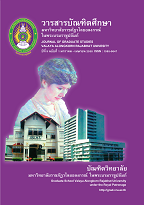ยุทธศาสตร์การบริหารจัดการโรงพยาบาลเอกชนในยุคโลกาภิวัตน์
Main Article Content
Abstract
การวิจัยนี้มีวัตถุประสงค์คือ (1) เพื่อศึกษาปัจจัยที่มีอิทธิพลโดยตรงต่อการบริหารจัดการโรงพยาบาลเอกชนในยุคโลกาภิวัตน์ (2) เพื่อศึกษายุทธศาสตร์การบริหารจัดการโรงพยาบาลเอกชนในยุคโลกาภิวัตน์ การวิจัยนี้ใช้แบบผสานวิธี ประกอบด้วยการวิจัยเชิงปริมาณและการวิจัยเชิงคุณภาพ การวิจัยเชิงปริมาณดำเนินการโดยศึกษากลุ่มตัวอย่างจำนวน 400 คน กำหนดขนาดกลุ่มตัวอย่าง โดยการคำนวณ ตามสูตรของทาโร่ ยามาเน่ และสุ่มแบบชั้นภูมิตามสัดส่วนและการสุ่มอย่างง่าย จากผู้ที่ปฏิบัติงานในโรงพยาบาลเอกชนในเขตกรุงเทพและปริมณฑล โดยใช้แบบสอบถามและวิเคราะห์ข้อมูลด้วยสถิติเชิงพรรณนา ประกอบด้วย ค่าร้อยละ ค่าเฉลี่ย และค่าส่วนเบี่ยงเบนมาตรฐาน การวิจัยเชิงคุณภาพโดยใช้เทคนิคการคาดการณ์เชิงอนาคต Ethnographic Futures Research (EFR) ผู้ให้ข้อมูลที่สำคัญจำนวน 20 คน ที่เลือกแบบเจาะจงจากผู้บริหารโรงพยาบาล วิเคราะห์ข้อมูลด้วยวิธีวิเคราะห์เชิงเนื้อหาและการตีความ
ผลการศึกษา พบว่า
1. ปัจจัยที่มีอิทธิพลโดยตรงต่อการบริหารจัดการโรงพยาบาลเอกชนในยุคโลกาภิวัตน์ ประกอบด้วยปัจจัย (1) ด้านสภาพแวดล้อมภายนอก เช่น สภาพเศรษฐกิจ สังคม การเมือง และการเข้าสู่เขตประชาคมเศรษฐกิจอาเซียน เป็นปัจจัยที่มีความสัมพันธ์กับการบริหารงานยุทธศาสตร์ของโรงพยาบาล และ (2) ด้านการวิเคราะห์สภาพภายในองค์การ ตามยุทธศาสตร์ต่างๆ นั้น มีระดับความสัมพันธ์ปานกลาง แต่ผู้ปฏิบัติงานบางส่วนไม่ทราบว่าโรงพยาบาลมีการกำหนดวิสัยทัศน์อย่างไร และไม่ทราบว่า การทบทวนพันธกิจในอดีตของโรงพยาบาลที่ผ่านมา เป็นต้น มีความสัมพันธ์อยู่ในระดับน้อย เนื่องจากการจัดทำยุทธศาสตร์ดังกล่าว เพื่อป้องกันความรั่วไหลของข้อมูล จึงมีการจัดทำเพียงเฉพาะผู้บริหาร และกลุ่มหัวหน้างานเท่านั้น
2. ยุทธศาสตร์การบริหารจัดการโรงพยาบาลเอกชนในยุคโลกาภิวัตน์ ที่เหมาะสม นั้นประกอบด้วยยุทธศาสตร์ 5 รูปแบบ คือ (1) ยุทธศาสตร์ในการบริหารโรงพยาบาล ซึ่งโรงพยาบาลเอกชนควรจะต้องมีการศึกษาและกำหนดกลยุทธ์ในส่วนที่เกี่ยวข้องกับการศึกษาสภาพแวดล้อมภายใน-ภายนอก และใช้วิธีการตามหลักการการวิเคราะห์ SWOT ด้วยแนวคิด 7'S ตลอดจนกลยุทธ์แบบ Balance Score Card เพื่อนำมาสู่การกำหนดหลักเกณฑ์ในการประเมินผลยุทธศาสตร์ที่โรงพยาบาลปฏิบัติ และสามารถนำไปสู่การกำหนดเพื่อปรับปรุงยุทธศาสตร์ที่เหมาะสมกับโรงพยาบาลเอกชนต่อไป (2) ยุทธศาสตร์ด้านลูกค้า ทางโรงพยาบาลควรมีการกำหนดยุทธศาสตร์ที่สำคัญใน 3 ด้าน คือ 2.1 ยุทธศาสตร์ที่เกี่ยวกับพฤติกรรมผู้บริโภค 2.2 ยุทธศาสตร์ที่เกี่ยวกับระบบ การบริหารลูกค้าสัมพันธ์ 2.3 ยุทธศาสตร์ที่เกี่ยวกับการสร้างความภักดีของลูกค้าในโรงพยาบาล เพื่อทำให้โรงพยาบาลได้รับผลประโยชน์สูงสุดในการบริหารงานด้านลูกค้าสัมพันธ์ต่อไป (3) ยุทธศาสตร์ด้านการเงิน ทางโรงพยาบาลควรมีการกำหนดยุทธศาสตร์ที่สำคัญคือ ยุทธศาสตร์การเก็บเกี่ยว (Harvest) ที่เป็นการเก็บผลประโยชน์ที่คาดว่าจะได้รับ เพื่อนำไปช่วยในการจัดทำยุทธศาสตร์พัฒนาความมั่นคง (Sustainable) ของโรงพยาบาล เพื่อให้โรงพยาบาลมีการเติบโต (Growth) และรองรับการเข้าสู่ AEC (4) ยุทธศาสตร์ด้านกระบวนการภายใน โดยทางโรงพยาบาล จำเป็นจะต้องมีการควบคุมสภาพแวดล้อมต่างๆ ภายในโรงพยาบาล (Control Environment) มีการจัดกิจกรรมการควบคุม (Control Activities) ในด้านข้อมูลสารสนเทศ และการสื่อสารในโรงพยาบาล (Information and Communication) และจะต้องมีการติดตามและประเมินผล (Monitoring and Evaluation) เพื่อพัฒนาและหาข้อบกพร่องเชิงยุทธศาสตร์ต่อไป (5) ยุทธศาสตร์ด้านการเรียนรู้และเจริญเติบโต ทางโรงพยาบาลควรจะต้องมีการจัดและพัฒนาโรงพยาบาลให้เป็นองค์กรแห่งการเรียนรู้ เนื่องจากโรงพยาบาลแห่งการเรียนรู้เกิดจากการจัดบรรยากาศ กระบวนการ เงื่อนไข และฝึกทักษะ ให้บุคลากรเป็นบุคคลเรียนรู้ ตามหลักกลยุทธ์ที่องค์กรกำหนดไว้ และต้องอาศัยปัจจัยที่สำคัญ 5 ประการคือ การคิดเชิงระบบ การพัฒนาความเชี่ยวชาญในการสร้างพลังแห่งตน แบบจำลองความคิด การสร้างวิสัยทัศน์ร่วม และการเรียนรู้เป็นทีม ซึ่งปัจจัยข้างต้นนี้ เป็นปัจจัยที่จะช่วยให้องค์กรมีแนวทางในการบริหารจัดการภายในองค์กร ให้สามารถพัฒนาเป็นองค์กรแห่งการเรียนรู้ได้ในอนาคต
The objectives of this research were 1) to study the factors influencing directly private hospitals management in the globalization era and 2) to study the strategies of private hospitals management in the globalization era. The approaches of mixed methods research were applied by combining quantitative and qualitative methods. The quantitative research was conducted by studying the samples of 400 respondents which were derived from Taro Yamane’s formula, selected by proportional stratified random sampling technique and simple random sampling technique and samples were personnel of private hospitals in Bangkok and vicinity. The tool conducted data collection was a questionnaire and used such descriptive statistics to analyze data as frequency, mean and standard deviation. The qualitative research was conducted from the participants of the executives of private hospitals with 20 key informants and selected by purposive sampling technique. The data analysis consisted of content analysis and interpretation.
The research findings were as follows:
1. The factors influencing directly private hospitals management in the globalization era comprised of (1) the external environment factors namely socio–economic and political conditions and conditions on entering the ASEAN Economic Community and (2) The internal environment factors related to various strategies in overall were at a moderate level, but the practitioners did not known how the hospital had set up the vision and how to review the mission of hospitals as related at a low level because the vision formulation was done by the executives and managers in order to prevent the business data leakage.
2. The appropriate strategies of private hospitals management in the globalization era should be comprised of 5 models namely (1) private hospitals management should set up the strategies related the external to environment factors and the internal environment factors which must be based on the SWOT method, 7’S concept and Balance Scorecard strategies and conducted the criteria for evaluation of strategic implementation in order to prove the appropriate strategies of private hospitals. (2) The strategies on customers should be composed of 3 aspects: the customer’s behavior, the customers relation management system and the building up of customers royalty for maximum benefits in the customers relation management. (3) The financial strategies, the hospitals should set up such the key strategies as the harvest strategy that expected to receive for sustainable development with growth and prepared for the AEC entering. (4) The strategies on internal processes should be focused on the necessity of internal environment and activities controlling, utilizing the information and communication and monitoring and evaluation of development to find out the weakness of strategies. (5) The strategies on learning and growth should be organized by providing the climate, processes, conditions and skills for personnel learning and supplemented with the 5 disciplines consisting of systematic thinking, personal mastery, mental models, shared vision and team learning which would fulfill the complete learning organization.
Article Details

This work is licensed under a Creative Commons Attribution-NonCommercial-NoDerivatives 4.0 International License.
บทความทุกเรื่องได้รับการตรวจความถูกต้องทางวิชาการโดยผู้ทรงคุณวุฒิ ทรรศนะและข้อคิดเห็นในบทความ Journal of Global of Perspectives in Humanities and Social Sciences (J-GPHSS) มิใช่เป็นทรรศนะและความคิดของผู้จัดทำจึงมิใช่ความรับผิดชอบของบัณฑิตวิทยาลัย มหาวิทยาลัยราชภัฏวไลยอลงกรณ์ ในพระบรมราชูปถัมภ์ กองบรรณาธิการไม่สงวนสิทธิ์การคัดลอก แต่ให้อ้างอิงแหล่งที่มา


